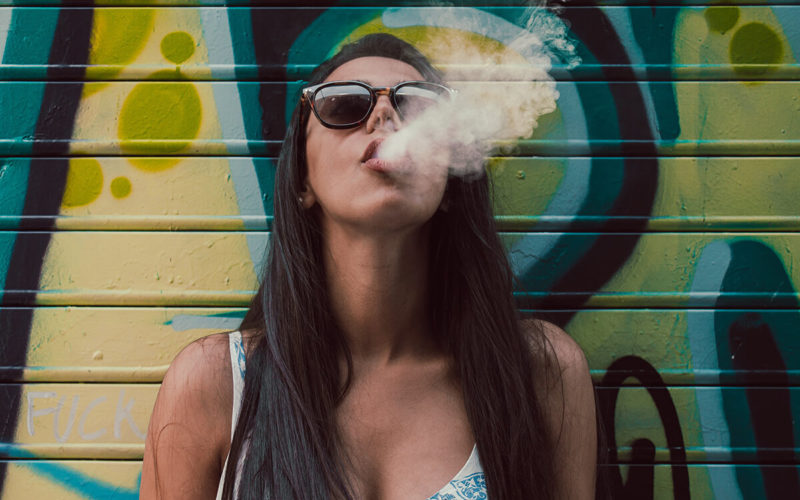It took me a decade after coming out to learn that there was a reason I and other bi women were experiencing so much sexual and intimate partner violence. In reality, we are at higher risk of gender-based violence than both straight women and other LGBTQ+ people. That’s not the only increased risk bi women face relative to straight women and bi men. Likely because of biphobia both within mainstream society and the LGBTQ community, bisexual women are also more likely to live in poverty. We are at higher risk of substance abuse.
Researchers have known for a while that LGBTQ people as a whole experience increased substance abuse. But until recently, a lack of research on the full spectrum of LGBTQ identities has left us without detailed information on how this affects different members of the community.
Megan S. Schuler is one of the researchers trying to change that. An Associate Policy Researcher at the RAND Corporation, a non-profit research institute, Schuler says that a mixture of biphobia, trauma from sexual violence, and poverty can significantly increase bi women’s risk. Analyzing survey data, Schuler and her co-researcher, Rebecca L. Collins, found that both lesbian and bisexual women use substances more than heterosexual women — and bisexual women are at the highest risk.
“There’s a full spectrum of substance use: substance use, and then substance use disorder,” says Schuler. Bi women are more likely to experience everything from marijuana use, which may be casual or occasional (40% of bi women use marijuana, as opposed to 26.1% of lesbian women and 10.3% of heterosexual women), to alcohol use disorder (12.5% of bisexual women, compared to 7.7% of lesbian women and 3.9% of heterosexual women) and opiod misuse (including 12.6% of bisexual women, 7.0% of lesbian women, and 3.5% of heterosexual women).
To understand why bisexual women experience these unique risks, it’s important to look at the specific kinds of discrimination we face, and the links between addiction and trauma. By understanding the root causes of the harm bi women experience, we can build more resilience for ourselves and our communities.
There Are Health Differences Across LGBTQ Identities
All women and LGBTQ+ people experience the negative effects of gendered discrimination. Yet different members of the LGBTQ community experience different kinds of violence and risk, due to both our unique LGBTQ identities and our intersecting experiences of racism, poverty, disability, immigration, and more.
Until recently, however, most public attention and research dollars went to studying the queer community as a whole, rather than paying attention to the individual needs of different orientations or identities. “Many have just compared sexual minority individuals as a group to heterosexual individauls as a group,” says Schuler. This often resulted in public health approaches that center the struggles and needs of privileged white, cis men.
In contrast, many LGBTQ people experience violence from multiple systems of oppression. Due to intense discrimination and a lack of resources, trans people — especially trans women of color — are at particularly high risk of depression, anxiety, and self-harm. Similarly, LGBTQ people of color and poor LGBTQ people, especially Black trans women, face a particularly high risk of both interpersonal and police violence. Undocumented LGBTQ individuals are also at high risk of victimization.
To truly liberate ourselves as LGBTQ people, we need to follow the lead of community activists, and pay attention to how our struggles intersect. By understanding how we differ, as well as how we’re united, we can center and uplift the most vulnerable members of our communities.
Bi women are particularly vulnerable
Bisexual women bear a particularly heavy trauma burden, a major factor in substance use. Discrimination increases our risk of sexual violence, poverty, and substance use. Each of these factors then exacerbate the others, creating a vicious cycle of vulnerability for many bi women.
While thirty-five percent of heterosexual women, and 44% of lesbian women, experience sexual or intimate partner violence — already disturbingly high rates — a full 61% of bi women are victimized. Some studies place this number at 75%. Additionally, 37.3% of bisexual men experience intimate-partner violence, a much higher rate than heterosexual men (29%) and gay men (26%).
Relatedly, 30% of bi women (both cis and trans), and of trans people of all sexual orientations live in poverty. This is substantially more than poverty rates for cis gay men (12%) and cis lesbian women (18%), which are identical to the poverty rates of their straight counterparts.
When it comes to substance abuse, trauma and poverty combine with discrimination to lead to queer women’s overall higher risk of substance use, with bi women experiencing the highest risk of all. Due to overlapping forms of discrimination, queer women of color have especially high substance use rates, according to Schuler. There is, unfortunately, still a gaping hole in the research on bi trans women’s substance abuse risk, but we do have evidence that trans women’s particularly high rates of sexual and partner violence victimization translate to increased mental health risk in general.
Because of this combination of discrimination, sexual trauma, substance use, and poverty, around 30% of women in the justice system are lesbian or bisexual, in contrast to 3.4% of the general U.S. population.
Discrimination and Trauma Hurt Bi Women’s Wellbeing
All of the kinds of trauma bi women experience are related. To understand and break this cycle, let’s look at some specific ways bisexual women experience discrimination and violence — specifically, biphobia.
Discrimination starts early
Studies have shown that peer discrimination and harassment against young LGBTQ people can increase our risk of future substance abuse. Bullying is particularly associated with bisexual young people’s increased alcohol use. “I think that trauma and rejection starting with early childhood and adolescence is really important,” says Schuler.
Young LGBTQ women report feeling higher levels of stigma than their male counterparts. This is particularly true for bisexual women, who often lack role models who are out and bi. Young bi women are surrounded by stereotypes that bisexuality isn’t “real,” that bi people are “actually” straight or gay and simply confused, or that bi people should “choose a side.”
“The sexual identity development process potentially is more prolonged or confusing” for bi women, says Schuler. “Bisexuality is not presented as a valid option.”
Biphobia exists in the LGBTQ community, too
Biphobia isn’t just present in mainstream society. It plagues the LGBTQ community, too. “Bisexual indvidiuals report a lot of stereotypes from sexual minority and non-minority partners,” says Schuler. “There’s potentially rejection on both sides.”
This includes stereotypes that bisexual people aren’t sufficiently committed to LGBTQ identity or the struggle for equality, or the pernicious idea that bisexual people are “prone to cheating” because they are attracted to more than one gender. Likely because of these in-group pressures, bisexual women who report being more out about their sexuality actually experience greater alcohol and drug use, especially if they feel greater discrimination.
Sexual trauma can lead to substance use
Trauma, such as sexual and intimate partner violence, leads to greater risk of substance abuse. Since bisexual women experience such high rates of sexual violence, it makes sense that, unfortunately, we may use substances to cope with that trauma.
“A lot of people report subsequently using substances to cope in part from constantly experiencing victimization,” says Schuler. This victimization partly stems from stereotypes of bi women as hypersexual. “Our standards of women regarding sexuality are clearly different than men. I think that’s the real magnifying factor,” says Schuler.
Researchers like Nicole Johnson, at Lehigh University’s Resistance Lab, back up this explanation, arguing that because bi women are stereotyped as indiscriminately sexual, our partners may use our bi identity as an excuse to coerce or control us. Bi women may turn to substances to help us cope with the resulting trauma. “Some substance use may be self-medication for psychological distress,” concurs Schuler.
Unfortunately, substance use can make us even more vulnerable to assault. This doesn’t mean, however, that our trauma is at all our fault. It means we need greater support to heal.
We Can Keep Each Other Safe
While these statistics sound grim, there are many reasons to remain hopeful. Those reasons are within each of us. They are our own resilience, our own capacity for love and healing, and our own solidarity and community building.
In order for bi women to truly access safety and healing, we need both societal change — better healthcare, access to safe housing, workplace protections — and community spaces where we can build ourselves up, and be free from discrimination and abuse. This is work we can do by ourselves and together, every single day. We can seek out groups, both online and IRL, specifically for bisexual people and bisexual women to come together and build our own power and healing. We can also care for ourselves by connecting with LGBTQ and bi-affirming mental health resources, especially if we’ve experienced some kind of sexual trauma or are worried about our substance use.
Above all, we can remember that whoever we are, whatever we do — whether we use drugs or not, are bi or queer, are survivors of sexual violence, are trans or poor or sex workers — we all deserve lives and communities free of violence and full of the love and material support we need to thrive.
Talkspace articles are written by experienced mental health-wellness contributors; they are grounded in scientific research and evidence-based practices. Articles are extensively reviewed by our team of clinical experts (therapists and psychiatrists of various specialties) to ensure content is accurate and on par with current industry standards.
Our goal at Talkspace is to provide the most up-to-date, valuable, and objective information on mental health-related topics in order to help readers make informed decisions.
Articles contain trusted third-party sources that are either directly linked to in the text or listed at the bottom to take readers directly to the source.




